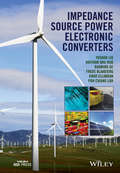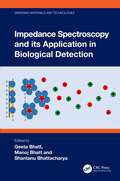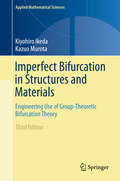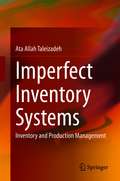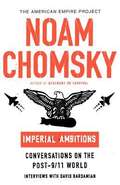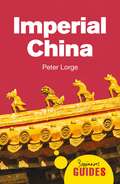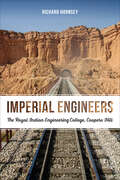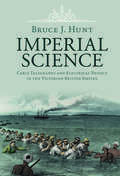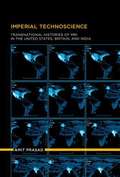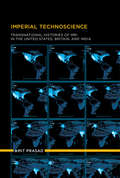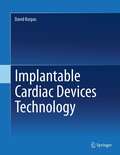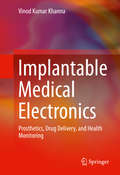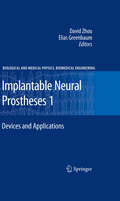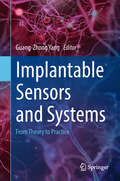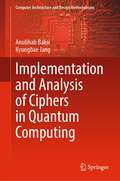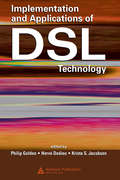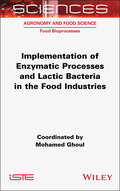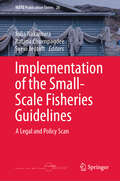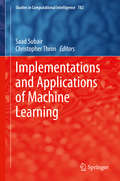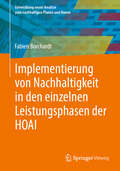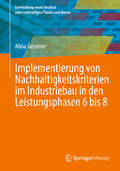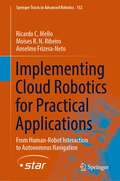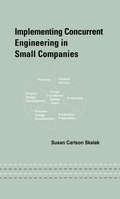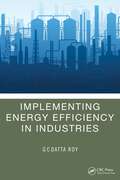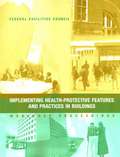- Table View
- List View
Impedance Source Power Electronic Converters
by Haitham Abu-Rub Omar Ellabban Yushan Liu Baoming Ge Frede Blaabjerg Poh Chiang LohImpedance Source Power Electronic Converters brings together state of the art knowledge and cutting edge techniques in various stages of research related to the ever more popular impedance source converters/inverters. Significant research efforts are underway to develop commercially viable and technically feasible, efficient and reliable power converters for renewable energy, electric transportation and for various industrial applications. This book provides a detailed understanding of the concepts, designs, controls, and application demonstrations of the impedance source converters/inverters. Key features: Comprehensive analysis of the impedance source converter/inverter topologies, including typical topologies and derived topologies. Fully explains the design and control techniques of impedance source converters/inverters, including hardware design and control parameter design for corresponding control methods. Presents the latest power conversion solutions that aim to advance the role of power electronics into industries and sustainable energy conversion systems. Compares impedance source converter/inverter applications in renewable energy power generation and electric vehicles as well as different industrial applications. Provides an overview of existing challenges, solutions and future trends. Supported by calculation examples, simulation models and results. Highly accessible, this is an invaluable resource for researchers, postgraduate/graduate students studying power electronics and its application in industry and renewable energy conversion as well as practising R&D engineers. Readers will be able to apply the presented material for the future design of the next generation of efficient power electronic converters/inverters.
Impedance Spectroscopy and its Application in Biological Detection (Emerging Materials and Technologies)
by Shantanu Bhattacharya Geeta Bhatt Manoj BhattThis book includes basics of impedance spectroscopy technology, substrate compatibility issues, integration capabilities, and several applications in the detection of different analytes. It helps explore the importance of this technique in biological detection, related micro/nanofabricated platforms and respective integration, biological synthesis schemes to carry out the detection, associated challenges, and related future directions. The various qualitative/quantitative findings of several modules are summarized in the form of the detailed descriptions, schematics, and tables. Features: Serves as a single source for exploring underlying fundamental principles and the various biological applications through impedance spectroscopy Includes chapters based on nonbiological applications of impedance spectroscopy and IoT-enabled impedance spectroscopy-based methods for detection Discusses derivations, substrates, applications, and several integrations Describes micro/nanofabrication of impedance-based biological sensors Reviews updated integrations like digital manufacturing and IoT This book is aimed at researchers and graduate students in material science, impedance spectroscopy, and biosensing.
Imperfect Bifurcation in Structures and Materials: Engineering Use of Group-Theoretic Bifurcation Theory (Applied Mathematical Sciences #149)
by Kiyohiro Ikeda Kazuo MurotaMost physical systems lose or gain stability through bifurcation behavior. This book explains a series of experimentally found bifurcation phenomena by means of the methods of static bifurcation theory.
Imperfect Inventory Systems: Inventory and Production Management
by Ata Allah TaleizadehThis book examines inventory and production strategies that can reduce unexpected breakdown costs. It highlights different EPQ models to deal with such problems, providing optimal value derivations for decision variables. It provides proofs for concavity or convexity of objective functions. The chapters also include numerical examples for all the developed mathematical models. Imperfect Inventory Systems: Inventory and Production Management and Breakdown should be useful for professionals working on supply chains, but also researchers in operations research and inventory management.
Imperial Ambitions: Conversations on the Post-9/11 World
by Noam Chomsky David Barsamian[From the book cover] Timely, illuminating, and urgently needed, this volume of interviews conducted by award-winning radio journalist David Barsamian features Noam Chomsky discussing U.S. policies in the increasingly unstable post-9/11 world. In these exchanges, appearing for the first time in print, Chomsky offers his frank, provocative, and informed views on the invasion and occupation of Iraq, the doctrine of preemptive strikes against so-called rogue states, and the growing threat to international peace posed by the U.S. drive for domination. In his inimitable style, Chomsky also dissects the propaganda system that fabricates a mythic past and airbrushes inconvenient facts out of history.
Imperial China: A Beginner's Guide (Beginner's Guides)
by Dr. Peter LorgeIn 221 BCE, the Qin state conquered its neighbours and created the first unified Chinese empire in history. So began the imperial era, where dynasties claiming divine assent ruled for more than 2,000 years. Borders shifted and emperors struggled to exert control over every region of their diverse territories. Elites held that they were inheritors of a rich, pre-imperial culture, while their society produced world-changing inventions such as the compass, printing, gunpowder and the gun. And imperial China itself was altered as it came into contact with others through trade, exploration and war. For anyone curious about this fascinating period, Peter Lorge introduces imperial China&’s major ruling dynasties, religions, arts, thinkers, inventions, military advancements, economic developments and historians.
Imperial Engineers: The Royal Indian Engineering College, Coopers Hill
by Richard HornseyEstablished in 1871 on the outskirts of London, the Royal Indian Engineering College at Coopers Hill was arguably the first engineering school in Britain. For thirty-five years the college helped staff the government institutions of British India responsible for the railways, irrigation systems, telegraph network, and forests. Founded to meet the high demand for engineers in that country, it was closed thirty-five years later because its educational innovations had been surpassed by Britain’s universities – on both occasions against the wishes of the Government of India. Imperial Engineers offers a complete history of the Royal Indian Engineering College. Drawing on the diaries of graduates working in India, the college magazine, student and alumni periodicals, and other archival documents, Richard Hornsey details why the college was established and how the students’ education prepared them for their work. Illustrating the impact of the college and its graduates in India and beyond, Imperial Engineers illuminates the personal and professional experiences of British men in India as well as the transformation of engineering education at a time of social and technological change.
Imperial Science: Cable Telegraphy and Electrical Physics in the Victorian British Empire (Science in History)
by Bruce J. HuntIn the second half of the nineteenth century, British firms and engineers built, laid, and ran a vast global network of submarine telegraph cables. For the first time, cities around the world were put into almost instantaneous contact, with profound effects on commerce, international affairs, and the dissemination of news. Science, too, was strongly affected, as cable telegraphy exposed electrical researchers to important new phenomena while also providing a new and vastly larger market for their expertise. By examining the deep ties that linked the cable industry to work in electrical physics in the nineteenth century - culminating in James Clerk Maxwell's formulation of his theory of the electromagnetic field - Bruce J. Hunt sheds new light both on the history of the Victorian British Empire and on the relationship between science and technology.
Imperial Technoscience
by Amit PrasadThe origin of modern science is often located in Europe and the West. This Euro/West-centrism relegates emergent practices elsewhere to the periphery, undergirding analyses of contemporary transnational science and technology with traditional but now untenable hierarchical categories. In this book, Amit Prasad examines features of transnationality in science and technology through a study of MRI research and development in the United States, Britain, and India. In an analysis that is both theoretically nuanced and empirically robust, Prasad unravels the entangled genealogies of MRI research, practice, and culture in these three countries. Prasad follows sociotechnical trails in relation to five aspects of MRI research: invention, industrial development, market, history, and culture. He first examines the well-known dispute between American scientists Paul Lauterbur and Raymond Damadian over the invention of MRI, then describes the post-invention emergence of the technology, as the center of MRI research shifted from Britain to the U.S; the marketing of the MRI and the transformation of MRI research into a corporate-powered "Big Science"; and MRI research in India, beginning with work in India's nuclear magnetic resonance (NMR) laboratories in the 1940s. Finally, he explores the different dominant technocultures in each of the three countries, analyzing scientific cultures as shifting products of transnational histories rather than static products of national scientific identities and cultures. Prasad's analysis offers not only an innovative contribution to current debates within science and technology studies but also an original postcolonial perspective on the history of cutting-edge medical technology.
Imperial Technoscience: Transnational Histories of MRI in the United States, Britain, and India (Inside Technology)
by Amit PrasadA study of science and technology practices that shows how even emergent aspects of research and development remain entangled with established hierarchies.In the last four decades, during which magnetic resonance imaging (MRI) has emerged as a cutting-edge medical technology and a cultural icon, technoscientific imaginaries and practices have undergone a profound change across the globe. Shifting transnational geography of tecchnoscientific innovations is making commonly deployed Euro/West-centric divides such as west versus non-west or “innovating north” versus “non-innovating south” increasingly untenable—the world is indeed becoming flatter. Nevertheless, such dualist divides, which are intimately tied to other dualist categories that have been used to describe scientific knowledge and practice, continue to undergird analyses and imaginaries of transnational technoscience. Imperial Technoscience puts into broad relief the ambivalent and contradictory folding of Euro/west-centrism with emergent features of technoscience. It argues, Euro/West-centric historicism, and resulting over-determinations, not only hide the vibrant, albeit hierarchical, transnational histories of technoscience, but also tell us little about shifting geography of technoscientific innovations. The book utilizes a deconstructive-empirical approach to explore “entangled” histories of MRI across disciplines (physics, chemistry, medicine, etc.), institutions (university, hospitals, industry, etc.), and nations (United States, Britain, and India). Entangled histories of MRI, it shows, better explain emergence and consolidation of particular technoscientific trajectories and shifts in transnational geography of science and technology (e.g. centers and peripheries).
Implantable Cardiac Devices Technology
by David KorpasDevelopment in a majority of medicine branches today is based on technological advancement. This is the case in cardiology, where medical devices designed to correct heart rhythm - pacemakers, cardioverters-defibrillators and biventricular systems - are implanted in order to help a sick heart. Medical pacing devices today are only developed and produced globally by a several producers who make different technical solutions, algorithms, system parameters etc. The book Implantable Cardiac Devices Technology is targeted at biomedical, clinical engineers, technicians in practice, students of biomedical disciplines, and all medical staff who are required to understand the basics of pacing technology. The book is comprised of fourteen chapters that are further subdivided according to specific topics. Chapters dealing with basic heart anatomy, physiology and arythmology are included for the sake of comprehensiveness. Chapters avoid the description of special functions, but cover general procedures and parameters common for the systems of all producers. The book is intended to serve as a monothematic textbook. In order to make the text comprehensible and well arranged for a reader, references to professional literature are only provided once in a respective chapter.
Implantable Medical Electronics
by Vinod Kumar KhannaThis book is a comprehensive, interdisciplinary resource for the latest information on implantable medical devices, and is intended for graduate students studying electrical engineering, electronic instrumentation, and biomedical engineering. It is also appropriate for academic researchers, professional engineers, practicing doctors, and paramedical staff. Divided into two sections on Basic Concepts and Principles, and Applications, the first section provides an all-embracing perspective of the electronics background necessary for this work. The second section deals with pacing techniques used for the heart, brain, spinal cord, and the network of nerves that interlink the brain and spinal cord with the major organs, including ear and eye prostheses. The four main offshoots of implantable electronics, which this book discusses, are: The insertion of an implantable neural amplifier for accurate recording of neural signals for neuroengineering studies The use of implantable pulse generators for pacing the activities of diseased organs The use of implantable sensors for observing the influence of therapy and monitoring a patient's biological parameters The use of drug delivery systems to supervise the supply of accurate doses of medicine to affected parts Readers will also find chapters on the ess entials of clocking and timing circuits, pulse generator circuits, neural amplifiers, batteries, biomaterials and biocompatibility, and more. Unique to this book is also a chapter on cyber security and confidentiality concerns with implants. End-of-chapter questions and exercises help readers apply the content to practical use, making this an ideal book for anyone wishing to learn more about implantable devices.
Implantable Neural Prostheses 1
by David Zhou Elias GreenbaumThis book and its companion volume describe state-of-the-art advances in techniques associated with implantable neural prosthetic devices and their applications. Researchers, engineers, clinicians, students and any specialist in this field will gain a deeper understanding of the neural prosthetic techniques currently available for a wide range of biomedical applications. In part one of this two-volume sequence, Implantable Neural Prostheses 1: Devices and Applications, the focus is on implant designs and applications. Devices covered include sensory prosthetic devices such as cochlear implants, auditory midbrain implants, visual implants, spinal cord stimulators, and motor prosthetic devices including deep brain stimulators, Bions, and cardiac electro-stimulators. Readers will also understand the regulatory approval process in the U.S. and Europe for implantable medical devices.
Implantable Sensors and Systems
by Guang-Zhong YangImplantable sensing, whether used for transient or long-term monitoring of in vivo physiological, bio-electrical, bio-chemical and metabolic changes, is a rapidly advancing field of research and development. Underpinned by increasingly small, smart and energy efficient designs, they become an integral part of surgical prostheses or implants for both acute and chronic conditions, supporting optimised, context aware sensing, feedback, or stimulation with due consideration of system level impact.From sensor design, fabrication, on-node processing with application specific integrated circuits, to power optimisation, wireless data paths and security, this book provides a detailed explanation of both the theories and practical considerations of developing novel implantable sensors. Other topics covered by the book include sensor embodiment and flexible electronics, implantable optical sensors and power harvesting. Implantable Sensors and Systems – from Theory to Practice is an important reference for those working in the field of medical devices. The structure of the book is carefully prepared so that it can also be used as an introductory reference for those about to enter into this exciting research and developing field.
Implementation and Analysis of Ciphers in Quantum Computing (Computer Architecture and Design Methodologies)
by Anubhab Baksi Kyungbae JangThis book deals with the upcoming threat that may be posed by quantum computers on modern-day security standards, particularly those involving symmetric key ciphers. Considering the progress in the field of quantum computing over the past few years, there is an ever-growing need to analyze the ciphers that are being employed in ensuring security. The symmetric key ciphers are generally considered safe against quantum computers, though one must consider the possible impact due to Grover's search algorithm (that reduces the security claim to the square root bound of what is expected against a classical computer). This book consolidates all the major research works in one place and presents it with adequate clarity, making the subject matter easy to understand for seasoned researchers and students alike. It covers the prerequisite information, new research works (including some of the state of the art), thought-provoking problems for further research, and all the relevant source codes. This book is interesting to engineers, researchers, and students who work/study in the field of cryptography.
Implementation and Applications of DSL Technology
by Hervé Dedieu Krista S. Jacobsen Philip GoldenThe digital subscriber line (DSL) industry is expanding rapidly and a technology once thought to be only transitional will soon clear $100 billion in total annual service revenue. From the world's leading DSL experts, Implementation and Application of DSL Technologies builds upon the theory presented in Fundamentals of DSL Technologies
Implementation of Enzymatic Processes and Lactic Bacteria in the Food Industries (ISTE Consignment)
by Mohamed GhoulConsumers are demanding healthy, natural food products with no environmental impacts. The use of ingredients of plant origin and the implementation of bioprocesses using enzymes and micro-organisms as biocatalysts represent a promising alternative to satisfy this demand. Implementation of Enzymatic Processes and Lactic Bacteria in the Food Industries focuses on describing the latest developments in the use of enzymatic biocatalysts and lactic acid bacteria in the food industry. The first part of the book is devoted to the presentation of different classes of enzymes, production and application processes, ways of improving enzymes and the main industrial applications using biocatalysts. The second part of the book describes a family of micro-organisms widely used in health food processing and formulation: lactic acid bacteria and bifidobacteria. Then, the most commonly used encapsulation matrices, encapsulation processes and the process of bacterial adhesion to these matrices are discussed. Finally, the best-known fermented foods and new approaches developed in this field are presented.
Implementation of the Small-Scale Fisheries Guidelines: A Legal and Policy Scan (MARE Publication Series #28)
by Svein Jentoft Ratana Chuenpagdee Julia NakamuraThis book provides a transdisciplinary assessment of multiple countries’ legal and policy frameworks vis-à-vis the Voluntary Guidelines for Securing Sustainable Small-Scale Fisheries in the Context of Food Security and Poverty Eradication, adopted in 2014 by the Committee on Fisheries of the Food and Agriculture Organization of the United Nations. Based on an appraisal framework used to facilitate the unpacking of those frameworks, this book collects country experiences and regional perspectives on a range of cross-cutting issues underpinning the protection of the rights and the promotion of justice for small-scale fishers and their communities.This book aims to be the first collection to present a systematic and in-depth assessment of existing national legal and policy frameworks vis-à-vis the SSF Guidelines. This assessment is done through the transdisciplinary and collaborative work of researchers, governments, and civil society organizations for the analysis of the cross-thematic questions, which the contributors of this book aim to address. Firstly, what are the relevant laws and policies that matter for securing rights of small-scale fishers and their communities? How are small-scale fisheries defined by national laws and policies? How are small-scale fisheries treated (i.e., specifically or generally) in these instruments? Are there specific provisions and references to small-scale fisheries or any of its associated terminologies (e.g., artisanal, subsistence, traditional, indigenous)? Secondly, how the relevant instruments address the 8 small-scale fisheries key issues outlined in that rapid appraisal study? What are the strengths and gaps in these instruments? Do they address issues that are not covered by the SSF Guidelines? Do they contribute to clarifying other legal issues that are relevant for sustainable small-scale fisheries? Finally, since the book also aims to explore the accessibility of these legal and policy instruments for those to which they matter the most (the small-scale fishers), the following questions were also considered: What challenges do they face in knowing and understanding the relevant laws and policies in place? Which tools, measures and processes are available in the countries to ensure small-scale fishers can claim for their rights? To what extent judicial courts have recognized and/or granted rights to small-scale fishers?Chapters 11 and 20 are available open access under a Creative Commons Attribution 4.0 International License via link.springer.com.
Implementations and Applications of Machine Learning (Studies in Computational Intelligence #782)
by Saad Subair Christopher ThronThis book provides step-by-step explanations of successful implementations and practical applications of machine learning. The book’s GitHub page contains software codes to assist readers in adapting materials and methods for their own use. A wide variety of applications are discussed, including wireless mesh network and power systems optimization; computer vision; image and facial recognition; protein prediction; data mining; and data discovery. Numerous state-of-the-art machine learning techniques are employed (with detailed explanations), including biologically-inspired optimization (genetic and other evolutionary algorithms, swarm intelligence); Viola Jones face detection; Gaussian mixture modeling; support vector machines; deep convolutional neural networks with performance enhancement techniques (including network design, learning rate optimization, data augmentation, transfer learning); spiking neural networks and timing dependent plasticity; frequent itemset mining; binary classification; and dynamic programming. This book provides valuable information on effective, cutting-edge techniques, and approaches for students, researchers, practitioners, and teachers in the field of machine learning.
Implementierung von Nachhaltigkeit in den einzelnen Leistungsphasen der HOAI (Entwicklung neuer Ansätze zum nachhaltigen Planen und Bauen)
by Fabien BorchardtDas Buch bietet einen allgemeingültigen Leitfaden zur Implementierung von Nachhaltigkeitsaspekten in den einzelnen Leistungsphasen der HOAI. Dieser Leitfaden bezieht sich auf die Planung, Ausführung, Bewirtschaftung und Verwertung eines Neubaus hinsichtlich öffentlicher Gebäude. Die Inhalte und Beiträge des Leitfadens werden durch eine ausführliche Untersuchung des derzeitigen Standes der Technik und der Forschung angefertigt. Dabei werden die derzeitigen Regelwerke bzw. gültigen Standards, Bewertungs- und Zertifizierungssysteme, aktuelle Forschungsarbeiten sowie existierende Leitfäden begutachtet und für die eigene Arbeit bewertet. Der thematische Schwerpunkt dieser Arbeit liegt auf der anschließenden Entwicklung eines Leitfadens, welcher Nachhaltigkeitskriterien für die unterschiedlichen Stakeholder eines öffentlichen Bauvorhabens sowie deren Leistungsphasen gemäß HOAI festlegt. Die Nachhaltigkeitskriterien orientieren sich an der Optimierung der ökologischen, ökonomischen, soziokulturellen und technischen Qualität sowie an der Prozess- und Standortqualität des zu erstellenden Gebäudes. Neben den Leistungsphasen nach HOAI werden ebenso die „Phase 0“ sowie „Phase 10“ betrachtet. Somit soll eine ganzheitliche lebenszyklusorientierte Betrachtung eines Gebäudes durch den Leitfaden ermöglicht werden. Der Leitfaden stellt die allgemeine Vorgehensweise und Methodik zur Implementierung von Nachhaltigkeitsaspekten in der Planung, Ausführung, Bewirtschaftung und Verwertung eines Neubaus dar. Mit Hilfe der Erstellung des allgemeingültigen Leitfadens für öffentliche Bauvorhaben soll eine Grundlage für die Erstellung eines nachhaltigen Neubaus geschaffen werden. Ein abgeschlossenes Bauvorhaben wird mit dem erstellten Leitfaden evaluiert. Hierbei wird auf die Verbesserungspotentiale zur Implementierung weiterer Nachhaltigkeitsaspekte für zukünftige Bauprojekte öffentlicher Auftraggeber eingegangen.
Implementierung von Nachhaltigkeitskriterien im Industriebau in den Leistungsphasen 6 bis 8 (Entwicklung neuer Ansätze zum nachhaltigen Planen und Bauen)
by Alina GerstnerDie Bauindustrie trägt wesentlich zu einer nicht nachhaltigen Lebensweise bei, da sie unter anderem signifikant hohe CO₂-Emissionen, einen großen Flächen- und Ressourcenverbrauch sowie erhebliche Abfallmengen verursacht. Um nationale als auch globale Nachhaltigkeitsziele zu erreichen und eine lebenswerte Umwelt zu sichern, muss die Bauwirtschaft Verantwortung übernehmen und Bauvorhaben zielstrebig nachhaltiger planen und umsetzen. In diesem Buch wird ein Leitfaden zur Implementierung von Nachhaltigkeitskriterien speziell für Industriebauten entwickelt, der in der Objektplanung Anwendung finden soll. Der Fokus liegt dabei auf den Leistungsphasen 6 bis 8 der HOAI, da diese Phasen – welche die Ausschreibung, Vergabe und Bauausführung umfassen – als besonders relevant für die Sicherstellung einer nachhaltigen Bauweise gelten. Sie können als Schlüsselphasen betrachtet werden, in denen geplante Nachhaltigkeitsziele konkret überführt, konkretisiert sowie anschließend in der Praxis umgesetzt werden müssen. Der Leitfaden soll die Objektplanung dabei unterstützen, konkrete Ziele und Maßnahmen vorzugeben, um die Realisierung eines nachhaltigen Industriebaus zu gewährleisten. Dabei werden relevante Regelwerke, Zertifizierungs- und Bewertungssysteme sowie wissenschaftliche Arbeiten und bestehende Leitfäden detailliert untersucht. Neben den Zielsetzungen und den entsprechenden Maßnahmen jeder Leistungsphase fließen auch verschiedene Nachhaltigkeitsdimensionen wie Ökologie, Ökonomie und Soziales in die Bewertung ein, um damit eine ganzheitliche und umfassende Betrachtung der Nachhaltigkeitsaspekte zu gewährleisten. Weiterhin sollen zur Förderung einer flexiblen Gestaltung auch spezifische Projektanforderungen, wie z.B. Vorgaben der EU-Taxonomie, Zertifizierungsindikatoren oder die individuellen Wünsche des Bauherrn berücksichtigt werden. Abschließend wird der Leitfaden in einem Referenzprojekt angewendet und evaluiert, um die Praxistauglichkeit zu überprüfen und Möglichkeiten für dessen Optimierung bei zukünftigen Industriebauprojekten zu identifizieren.
Implementing Cloud Robotics for Practical Applications: From Human-Robot Interaction to Autonomous Navigation (Springer Tracts in Advanced Robotics #152)
by Ricardo C. Mello Moises R. Ribeiro Anselmo Frizera-NetoThis book explores cloud robotics by casting a light on key issues and proposing a novel approach towards implementation and practical aspects to allow for the widespread adoption of cloud-based functionality. The advent of cloud robotics can to unleash a new generation of smart robotic devices by allowing robots to explore cloud computing capabilities to share data and to offload heavy processing applications. Cloud robotics is investigated as an enabler to a series of applications and devices, questioning how the insertion of network and cloud technologies into such systems might affect the interaction between a robot and the human operating it, and what are the limiting requirements for cloud-based solutions. Aiming at researchers and practitioners, this book also presents a methodology based on open-source software and commercial off-the-shelf devices to provide a common standard for reproducing and benchmarking different cloud robotics systems.
Implementing Concurrent Engineering in Small Companies
by Susan SkalakPresenting a systematic approach to concurrent engineering (CE), this reference accommodates the small corporation's quest to incorporate better design management practices. The author provides an easy-to-follow methodology that eliminates the need for costly consultants, promotes environmentally friendly solutions, and introduces three main design models to aid in new, evolutionary, and incremental product design. She also examines how the adoption of CE practices improves overall performance. Topics include engineering specifications for product parameters, conceptual and embodiment design, vendor selection and approval, prototyping, and line and equipment installation.
Implementing Energy Efficiency in Industries
by G C RoyThis book focuses on designing, implementing, and verifying the performance of energy efficiency and conservation (EE&C) projects in relevant industries from a practitioner’s perspective. Various techniques and approaches are presented using case studies collated from the author’s notes from about four decades of working in process industries and two decades as an international sustainable energy consultant.Features: Provides a broad overview of the main issues in implementing energy efficiency in industries. Focuses on implementation issues – technical, financial and employee engagement. Provides a brief description on the fundamental thermodynamic principles that drive efficiency and conservation. Includes a comparative evaluation of ESCO performance contract implementation. Charts out the energy efficiency journey, developing long-term goals and short-term activities. Includes case studies related to energy efficiency in energy-intensive large industries. This book is aimed at professionals working in energy engineering, industry, efficiency, and policy.
Implementing Health-protective Features And Practices In Buildings: Workshop Proceedings
by National Research Council of the National AcademiesThe National Academies Press (NAP)--publisher for the National Academies--publishes more than 200 books a year offering the most authoritative views, definitive information, and groundbreaking recommendations on a wide range of topics in science, engineering, and health. Our books are unique in that they are authored by the nation's leading experts in every scientific field.
